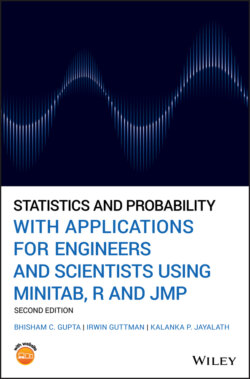Читать книгу Statistics and Probability with Applications for Engineers and Scientists Using MINITAB, R and JMP - Bhisham C. Gupta, Irwin Guttman - Страница 32
2.1 Getting Started with Statistics 2.1.1 What Is Statistics?
ОглавлениеThe term statistics is commonly used in two ways. On the one hand, we use the term statistics in day‐to‐day communication when we refer to the collection of numbers or facts. What follows are some examples of statistics:
1 In 2000, the salaries of CEOs from 10 selected companies ranged from $2 million to $5 million.
2 On average, the starting salary of engineers is 40% higher than that of technicians.
3 In 2007, over 45 million people in the United States did not have health insurance.
4 In 2008, the average tuition of private colleges soared to over $40,000.
5 In the United States, seniors spend a significant portion of their income on health care.
6 The R&D budget of the pharmaceutical division of a company is higher than the R&D budget of its biomedical division.
7 In December 2009, a total of 43 states reported rising jobless rates.
On the other hand, statistics is a scientific subject that provides the techniques of collecting, organizing, summarizing, analyzing, and interpreting the results as input to make appropriate decisions. In a broad sense, the subject of statistics can be divided into two parts: descriptive statistics and inferential statistics.
Descriptive statistics uses techniques to organize, summarize, analyze, and interpret the information contained in a data set to draw conclusions that do not go beyond the boundaries of the data set. Inferential statistics uses techniques that allow us to draw conclusions about a large body of data based on the information obtained by analyzing a small portion of these data. In this book, we study both descriptive statistics and inferential statistics. This chapter discusses the topics of descriptive statistics. Chapters 3 through Chapter 7 are devoted to building the necessary tools needed to study inferential statistics, and the rest of the chapters are mostly dedicated to inferential statistics.
